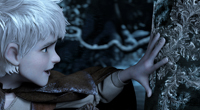
‘Rise of the Guardians’ gave DreamWorks’ FX team a fantastic chance to help character performances come to life on screen.
The Guardian Effect |
|
‘Rise of the Guardians’ represented a chance for the effects team at DreamWorks to become integrally involved with characters as they perform on screen. Some of the extraordinary characters in the film – in particular Sandman, Jack Frost and the evil Pitch Black – express themselves through magical, sometimes beautiful and always exciting effects that become part of their signature look and presence, affecting the environment around them. Head of Effects Yancy Lindquist said, “On a typical production we’ll focus our effort on a handful of key effects shots that represent our big moments to shine. Otherwise we serve in a supporting role to the performances and drama. But this time, we had a chance to move up to a character-like status. We were more directly in the audience’s eye and responsible for a level of expression throughout the movie. For us, this was a defining factor for the whole production - personality and performance had to shine through in each effect.” |
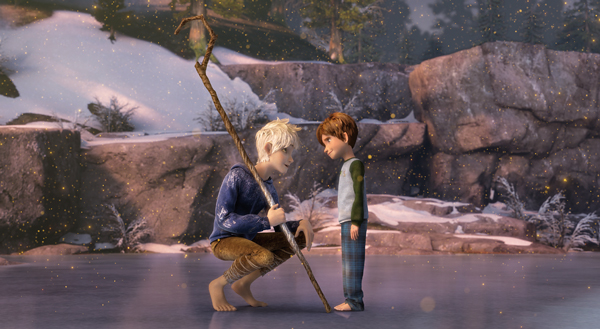 |
SandmanDreamworks’ Art Department, headed by production designer Patrick Hanenberger, generally puts together a look for the character effects expressed as paintings and imagery which the effects artists use a guide and reference as they start researching and developing each effect. But sometimes the process and timing doesn’t work out so neatly. For example, one of the most distinctive, eye-dazzling effects across the movie was the use of particles, especially Sandman’s sparkling golden sand particles. “The Sandman character’s development and looks had passed through so many iterations that by the time our team had to get moving on the sand effect there still wasn’t much definitive artwork available,” said Yancy. “So we began compiling our own collection of reference material from other movies, from YouTube and live action reference we shot ourselves. Combining this with discussions with the director Peter Ramsey and VFX supervisor David Prescott, we started experimenting with different ideas. Our original attempts were more like real sand than the final result – no glowing or glistening. It still had a matte look at that stage with some glitter but no internal illumination of its own.” Magical ZoneAs they continued experimenting and the story and characters themselves progressed, influences from Peter Ramsey and David Prescott pushed the look into a more magical zone. “The look to avoid here, in fact, was ‘pixie dust’. It still needed to feel like real sand. Once we had it feeling right we could start using it to build 3D shapes and then the flowing sand streams.” |
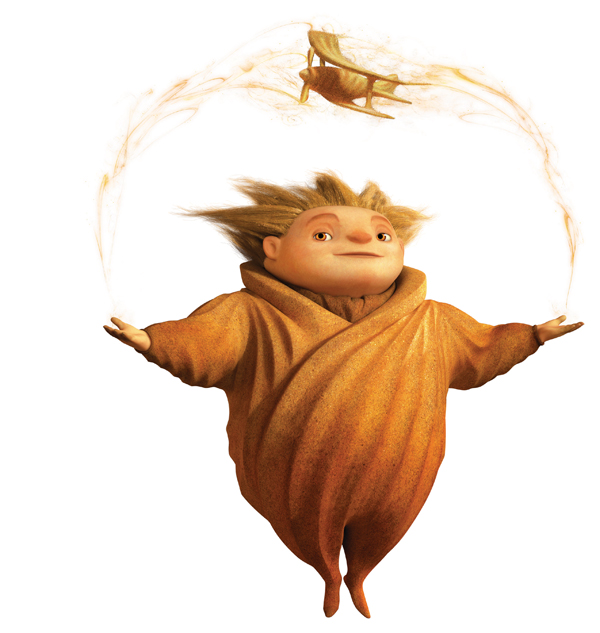 |
|
In the early stages they leaned toward relying on fluid techniques and trying to get the particles to travel along with fluid simulations. This worked and looked quite beautiful but didn’t allow enough control, especially regarding the speed at any given moment. Straight particle simulations gave more control but lacked the natural flowing, lyrical quality they wanted the sand to have. The other extreme was a deterministic or procedural approach, highly controllable but without an organic feeling. As they worked on the sand they gradually stopped thinking of it as an exclusive, one-path system. After testing the various options they developed a hybrid approach that covered the different looks and behaviour it had to display. Yancy said, “It wasn’t as straightforward as packaging up our sand effect, generated with a linear, tested system where we could input data into one end and have sand coming out the other. Non-linear Sand SystemInstead we considered the sand process as a series of tools we were compiling to be used in different combinations for different results and effects each time. Any of these combinations might involve fluid, procedural or particle simulations. DreamWorks’ proprietary fluid simulation software Flux was very useful here because it has been developed for speed and currently can work much faster than third party applications, which left us more time for looks and detail work. “In fact, for efficiency’s sake, a single linear system is normally the preferred route. Because the Nightmares, for example, Pitch Black’s thundering herd of black horses, had very specific actions to perform, we were able to create one system that produced the flowing trails to run out behind the Nightmares and then break off into tiny bits of sand. We could, in effect, run the Nightmares through the system and they would emerge complete with particles applied with the expected looks. We would only need to tweak parameters.” |
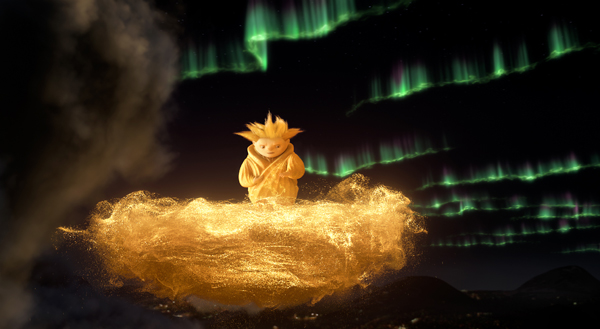 |
|
When an effect can be achieved this way it means they can nail the process – how they will create it – in one stage and spend the rest of their time being creative and artistic with the looks. But the sand had to perform in such diverse ways that they needed to develop a complete sand toolset. The tools were based on Houdini, customised so that the artists weren’t sitting down to start from scratch each time sand was called for, but not as specific as the Nightmares effect. StreamliningIdeally, look development and effects system development are more or less simultaneous on a feature project like this one. The effects team start each movie by identifying all the effects in the script they will need to produce and in particular, earmark the major, recurring ones for early development. In these cases, not only will the systems and simulations need to be efficient, but the effects will also impact on the rest of the production, so everyone needs to know what they look like and start planning how to work them into the story. Thus the golden sand and Pitch Black’s black sand effects needed about a year of experimentation and development, deciding first on the looks, leading to the system build, and then preparing for production and ease of use. “After the experimental, artistic phase, spent making the effects happen the way we want them to, the process itself can be fairly messy to use – we can make it work but only with some difficulty,” Yancy said, “so we have to streamline it a little.” Interactive IlluminationThe ultimate look of the sand involved illumination. This sand glows and sparkles, emitting light from within. As early as possible, the VFX team handed their work over to the lighting team where point-based global illumination was used on a per-shot basis to establish interactive lighting. “For example, if the shot required animating a sand stream passing by a tree and among some buildings, as soon as we had put out some rough simulations, we would contact the lighters and pass a temporary set of points that could be used to illuminate other items in the scene,” Yancy explained. |
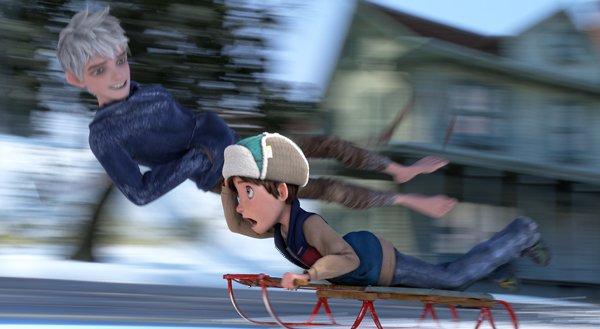 |
|
“In this way, both departments could work in tandem throughout the production. As the effects artists refined their work, the lighters were rendering the backgrounds. We could put these elements together and observe exactly how the sand streams were lighting up the surrounding environment. Then the director and VFX supervisor could view the results as work progressed and provide comments and suggestions on both the light and the sand.” The Dark SidePitch Black’s black sand caused less concern about its effect on the surrounding environment. It was necessary to hand off shadow and occlusion passes but the integration was simpler without the interactive lighting element. However, to make its looks align with the Nightmares more effectively they worked with the surfacing department, where the artists had designed a gritty surface look combined with purple and blue iridescence. The effects team investigated how this had been created – which reflection maps, for example, and imitated the same look in their particle rendering. Their work resulted in a different feeling for this black sand representing an evil influence compared to Sandy’s benevolent golden sand. The style of its animation has also been contrasted. Instead of Sandy’s lyrical, happy flowing action, Pitch Black’s sand called for a creepy kind of movement. They made the front edge of the flow pointier, shapes within the simulation slightly more angular, but something more distinctive was needed. As an experiment they took some of the same simulations and ran them backwards, combining them with areas that were moving forward. |
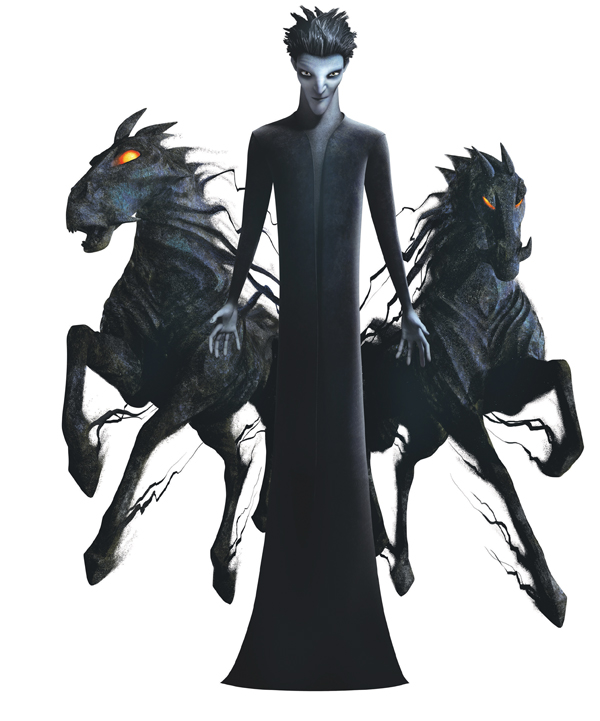 |
|
“The result was quite eerie and realistic, consistent with the uncanny look of any familiar action viewed in reverse, and especially evident in Pitch’s dark cloud and the movement of the black sand over the Guardians’ globe. It wasn’t quite as simple to achieve as reversing the action but the animation was based on that look,” Yancy said. Frost Dynamics and OpenVDBJack Frost had his own signature effect as well. The team went through another R&D stage looking for ice crystals and snow flakes that were shimmering and beautiful but also dynamic and able to form a pattern. The team’s developer for this effect devised a technique based on cellular automata. Wherever a frost pattern needed to grow, he would scatter points across that surface and then run the cellular automata simulation, using these as the starting points. He established a system whereby none of the points would be activated or turned ‘on’ until its neighbour was turned on. This rule produced a rippling effect running across the object surface. The artists could also paint areas onto a shot where they wanted the frost to grow. This could include quite specific instructions as well as location, such as directionality, spots where crystals should NOT grow, or where the effect should be slower. This workflow gave everyone considerable control. When the artists had finished painting instructions and ran the simulation, the cellular automata would define a direction for the frost’s growth. As soon as the developer had the direction information he could trace curves through that direction, placed inside of a volume grid preventing the curves from intersecting. He was using a volume format calledOpenVDB, originally developed at DreamWorks and used as a proprietary farmat, and now released as an Open Source resource. |
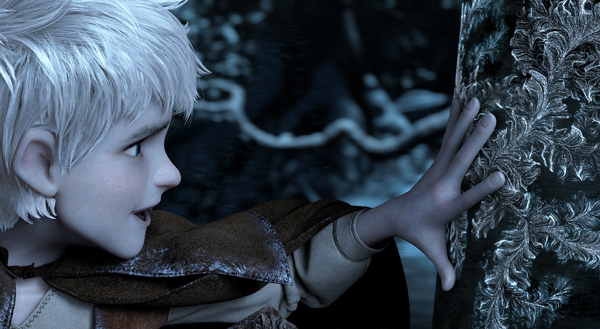 |
|
OpenVDB is a hierarchical data format and associated tools for manipulating volumetric data. The structure stores sparse, three-dimensional voxel grids in a compact form. It uses effectively infinite index space, compact storage in memory and on disk, and fast random and sequential data access. The algorithms released with the format handle operations such as filtering, compositing, constructive solid geometry, sampling and voxelization from other geometry. OpenVDB was also used in the DreamWorks movies ‘Puss in Boots’ and ‘Madagascar 3: Europe's Most Wanted’. Yancy also said, “OpenVDB allows extremely high volume resolutions, that is, it can support lots of detail without taking up a lot of memory. It is also very fast. On this project it really helped us get the most detail out of our models without being slow and cumbersome to work with.” Angry FrostThus the developer could trace the effect through that volume grid, which served the two functions of locating the curve and its direction and also preventing the curves from intersecting. With that frost pattern set up, small tendrils could extend from it but wouldn’t tend to cross each other until directed to. In that case, straight lines would be introduced, which would intersect with the curves producing a jagged effect that expressed Jack’s moments of anger in the story. |
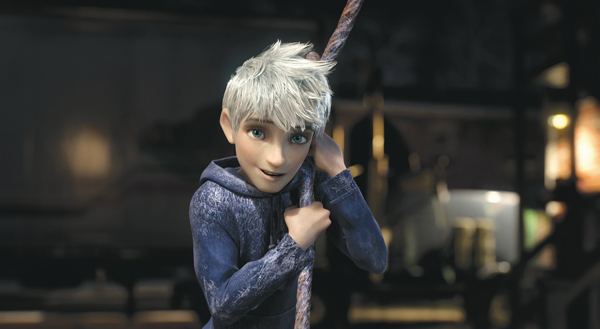 |
|
“We were not necessarily devising groundbreaking or completely original types of effects,” said Yancy. “The major influence on the development of all of these effects was the need to design each one to work with a character’s personality and express his mood, like Jack and the frost. Working with cellular automata is not a new technique but the developer focussed on using it in this expressive, compelling way.” To establish that close integration of effects and characters, early in the production the head of character animation Gabe Hordos and VFX supervisor David Prescott planned with the two teams how to maintain closer contact than usual for this project. At weekly meetings with the animation department, instead of only hashing through existing or past issues, the effects artists aimed to look ahead to what characters the animators would be working on next in order to be there alongside them, developing their effects in tandem. Sand SurfacingFor example, when Jack suddenly begins creating objects and creatures out of the golden sand, one of them is a full-sized dolphin. The artists discussed with the animators not only how the dolphin could swim through the air around him but also suggested that it dive below the level of the main sand stream, turn temporarily into bubbles, and then ‘resurface’ and reform again. This kind of creative interchange continued through most of the production period to make sure the effects were in place as early as possible and became a part of the animation. |
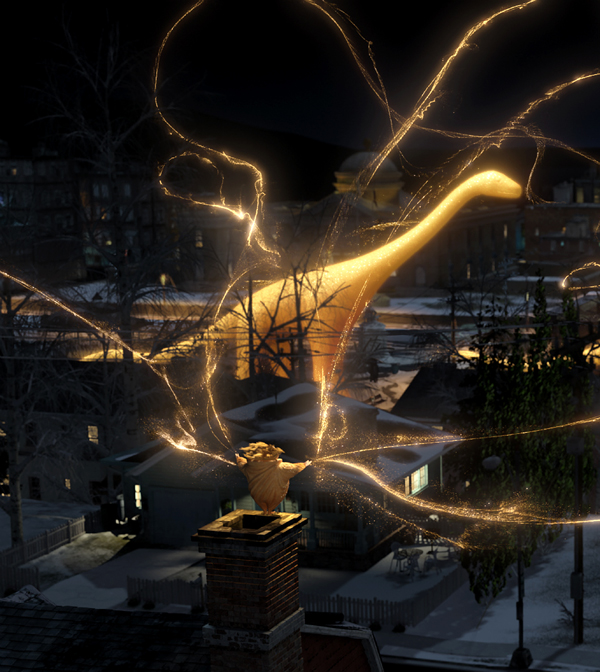 |
|
It also avoided the look of an animated character with an independent effect layered on top of it. The character could react to the effect, and the effect itself looks alive and interesting. The sand animations – which included airplanes and dinosaurs - started as physical objects animated by the animation team, but then had to be entirely moved into the effects realm and turned into sand, one way or another. At first the effects artists envisioned constructing all such objects from particles. But when it came time to produce and complete the first trailer, which included some of the sand creatures, creating them in this way amounted to so much work that they realised they needed a more efficient approach and called on the surfacing department for help. Depending on the shot, they made decisions about which of the creatures and objects had to be fully built of sand and which could be surfaced to look like sand. The surfacing team devised a technique of scattering points over the surfaces of creatures to give a consistent sand look. The Sandman character himself was given a sand texture, to which they added a further set of particles over the surface to give it extra dimension. To the process, the effects team shared their particle techniques to become a part of the surfacing technique. www.dreamworksanimation.com |
| Words: Adriene Hurst Images: Courtesy of Paramount Pictures/Dreamworks Animation |


















